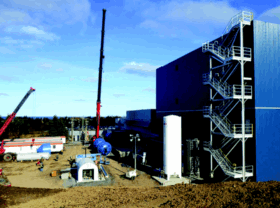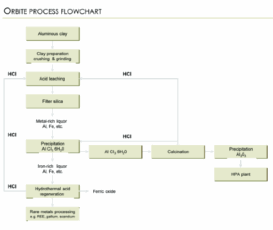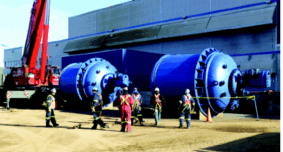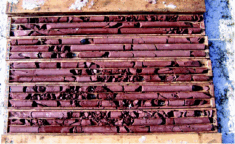Canadian scientists hook up with worldwide waste management specialists to introduce a technology breakthrough that will reclaim the scourge of bauxite beneficiation
By Steve Fiscor, Editor-in-Chief
 |
| Orbite Aluminae recently transformed its commercial-scale demonstration plant into a high-purity alumina plant. |
Estimates indicate that more than 4 billion tons of red mud will have accumulated in piles of various sizes around the world by 2015-2018. The Bayer process, which refines bauxite to produce alumina (aluminum oxide), generates a significant waste stream. Since its inception in the late-1800s, the only option was to impound the caustic red mud. On occasion, red mud discharges have created environmental calamities, such as the Ajka sludge spill in western Hungary during 2010.
On average, bauxite contains about 40% to 50% alumina. The Bayer process uses a hot solution of sodium hydroxide to digest the ore. It converts the alumina into sodium aluminate. The other solid impurities do not dissolve and are filtered off. As the alkaline solution cools, aluminum hydroxide precipitates. The solid impurities are mostly a mixture of silica (sand), iron oxides (red color) and titanium dioxides.
The amount of silica in bauxite can range from a few percentage points to as much as 10%. The ratio of alumina to silica is what really determines the quality of bauxite ore. The best bauxite ores have the highest ratio of alumina to silica and the lowest quality bauxite, vice versa. As a general rule of thumb, processing the best bauxite generates about 2 tons of red mud per ton of alumina. As the percentage of silica increases so does the amount of red mud. At more than 10% silica, the Bayer process becomes uneconomical because of red mud.
 |
A Canadian company, Orbite Aluminae Inc., has found a way to not only refine alumina without producing red mud, it can also extract smelter-grade alumina, as well as other products such as rare earth metals, from existing red mud impoundments. In early February, Orbite announced it was teaming up with Veolia Environmental Services, a worldwide waste management firm whose specialties include wastewater treatment processes, to treat and recycle red mud worldwide. Together they will build the first of many plants to treat red mud using the Orbite Aluminae process.
A Different Approach
“The Bayer process is an inefficient, caustic process,” said Richard Boudreault, president and CEO of Orbite Aluminae. “The digestive system only captures about half the alumina and the remaining alumina and iron attaches itself to the atoms into red mud compounds. Nearly all of the iron ore is then locked into the silica. So, a lot of the metal is lost to the red mud. Our approach is much different as we recover most of what is in the ore.”
The Orbite Aluminae process also digests the metals, but it uses an acid instead of a base. “We use the same acid found in the human stomach, hydrochloric acid (HCl),” Boudreault said. “The human stomach avoids digesting the silica found in food. Likewise, in our process, silica is never put into the solution and the red mud never forms.”
 |
| Jerome Le Conte, senior executive vice president, Environmental Services Division, Veolia (left), and Richard Boudreault, president and CEO, Orbite Aluminae. |
The process of using an acid to digest bauxite, however, has historically been difficult to manipulate. HCl will try to eat away at everything, including the container. Orbite Aluminae has used a process where it sprays glass on the walls of the container (or digester). It’s a new technology that did not exist until a few years ago. The glass lining allows the use of an acid-based process without destroying the equipment.
According to CRU reports, the alumina industry’s average production cash cost could reach $275/mt in 2013 and $320/mt by 2022. Orbite expects its production costs to be $208/mt of alumina. Factoring in the possible sale of byproducts, the costs could be reduced to a negative cost for alumina.
Boudreault estimates that the alumina generated by the Orbite process could pay for the investment in as little as one to two years at current prices. “There will certainly be a positive return on investment for this process,” Boudreault said. “That doesn’t mean we do not expect the red mud producers to pay the tipping fees. They pay some $5/ton to $50/ton to store this material. That’s a high cost.” The Orbite process could save bauxite miners substantial amounts of money directly and indirectly by reducing the cost for environmental insurance.
The current plan, Boudreault explained, is to start with Europe where the bauxite processors pay a great amount of money per square foot for land. “We will also work with the Chinese,” Boudreault said. “The Chinese actually have the first environmental laws on the books that say they will recover 20% of all of the red mud by 2015. We will work with these regions from the onset. We are hoping to install our first plant within a year or so.”
Orbite Aluminae has been issued patents in China and Russia that protect the processes, which are currently being demonstrated at its high-purity alumina (HPA) plant in Cap-Chat, Quebec, as well as processes that will be used in its first smelter-grade alumina (SGA) plant, which is currently at the feasibility study stage. China and Russia are the largest aluminum producing regions in the world.
How it Works
Orbite’s proprietary process uses semi-continuous leaching in HCI to produce alumina. It has achieved high recovery rates for alumina, rare earth elements (REEs), and rare metals, including 93% of the Al2O3 from a regional aluminous clay deposit and an average recovery rate of 90% for all other elements.
 |
| Reactors rest on their sides before being placed in the HPA Plant. |
The process involves two phases: hydrochloric leaching of the substrate is used to release the aluminates as chlorides, then acid regeneration recovers the hydrochloric acid from the mother liquor while converting other metallic components to oxides. The acid regeneration portion of the process allows Orbite to extract byproducts while still recovering the hydrochloric acid.
The Orbite process can be broken down into the following steps: clay preparation, leaching (digestion), filtration of insoluble elements, alumina extraction, iron extraction and calcination. Meanwhile, byproducts and the regenerated acid are recovered from the mother liquor in a parallel process.
The aluminous clay is crushed and ground to maximize the surface area for acid leaching. Particles are acid-leached at a high temperature using HCl. All of the metals (except titanium, but including REEs) dissolve as chloride solutions. Specifically, alumina and iron dissolve to form aluminum trichloride (AlCl3) and ferric chloride (FeCl3). Silica and a small amount of titanium remain insoluble and are removed by filtering. The waste stream consists of pure silica (sand) containing some titanium. This material is non-toxic and could potentially be sold for commercial use in applications that range from optical-quality silicon to fracking sands.
The leachate is processed by first precipitating the AlCl3 and removing it as aluminum chloride hexahydrate. The aluminum chloride hexahydrate then goes through calcination and is transformed into alumina. The ferric chloride, which is still in the leachate, is hydrolyzed using a low-temperature process, producing a pure ferric oxide precipitate while regenerating hydrochloric acid. The ferric oxide (hematite) is very pure and can be sold commercially as a specialty byproduct. Remaining in the leachate are metallic solutions including magnesium, gallium, alkaline and rare earths, which are then recovered through standard extracting processes.
No acidic residue remains; the red mud that plagues the Bayer process is not an issue with the Orbite process. The ferric oxide and the metals that go to waste in red mud ponds in the Bayer process are recovered and sold as byproducts.
Cap-Chat Commissioning
The commissioning and optimization of Orbite’s first HPA plant is currently under way. The plant is designed to process aluminous clay from Orbite’s deposit in Grande-Vallée, Quebec. The 34 km2 deposit, a small portion of the corporation’s total claims, contains an indicated resource of more than 1 billion tons of aluminous clay. During March, Orbite shipped its first commercial samples of HPA with a minimum purity of 4N (99.99%) to customers in Europe, Asia and North America. The company has already received more than 25 confirmed orders for HPA samples ranging from 4N to 5N purity from clients throughout the world. Sample sizes range from 1 to 100 kg and the client tests can take several months to complete.
 |
| Core samples of aluminous clay taken from the Grande-Vallée deposit demonstrate its homogeneity. |
The global market for HPA has typically been for a 4N product but is shifting toward higher purities of 4N5 and 5N over the next few years. This market is driven in part by the phasing out of incandescent lights over the next few years throughout most major world markets, which is increasing the demand for LED lights containing substrates manufactured with HPA.
Following the installation of additional alumina calcination equipment, which is ongoing, the HPA production capacity is expected to gradually increase from less than 1 metric ton per day (mt/d) to 3 mt/d and then finally all the way to 5 mt/d.
Orbite plans to offer HPA powder and HPA granules ranging from 4N (99.99%) to an eventual 6N (99.9999%) purity. The company will also be expected to produce gallium and scandium oxides once a rare-metal recovery circuit is completed. The HPA plant is also a showcase for the technologies that will eventually be used at the company’s SGA plant.
During February 2013, the Quebec Ministry of Finance and Economics (MFE) named Orbite winner of the PerformAS Award, which recognizes Orbite’s achievements in furthering innovation and development of the chemical industry within the Province of Quebec.
There are currently at least 50 active red mud sites around the world. There are more than 100 inactive sites. Reclaiming red mud is perceived by the aluminum industry as the biggest environmental concern facing the industry.
Veolia will either work with alumina refiners or governments looking to remediate legacy deposits, which could be transformed into resources for a fee. It is already working with many countries on environmental regulations. “Veolia’s greatest strength is their capacity to operate these large projects and operate them safely and to secure the IP accordingly,” Boudreault said. The Orbite technology could also be used to remediate and reclaim other industrial waste, including fly ash from coal combustion.






